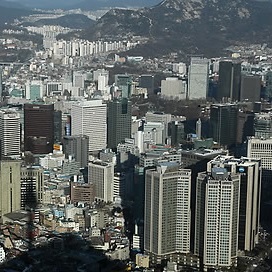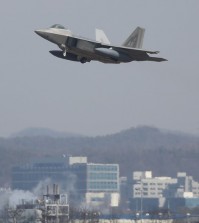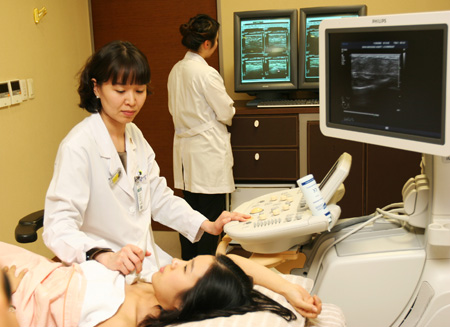- California Assembly OKs highest minimum wage in nation
- S. Korea unveils first graphic cigarette warnings
- US joins with South Korea, Japan in bid to deter North Korea
- LPGA golfer Chun In-gee finally back in action
- S. Korea won’t be top seed in final World Cup qualification round
- US men’s soccer misses 2nd straight Olympics
- US back on track in qualifying with 4-0 win over Guatemala
- High-intensity workout injuries spawn cottage industry
- CDC expands range of Zika mosquitoes into parts of Northeast
- Who knew? ‘The Walking Dead’ is helping families connect
S. Korea’s economy to grow 3.8 pct in 2015 according to OECD report

Although the OECD predicts economic growth for South Korea in 2015, it could come with a few unwanted side effects. (Yonhap)
SEOUL (Yonhap) — South Korea’s economy is expected to grow 3.8 percent in 2015 on the back of the government’s efforts to boost it through fiscal stimulus and monetary policy easing, a report by a leading international economic organization showed Tuesday.
The Organization for Economic Cooperation and Development (OECD) said in its Economic Outlook report that South Korea’s gross domestic product (GDP), the broadest measure of economic performance, will move up from the 3.5 percent growth forecast for this year.
This year’s growth forecast is down from the 4 percent projected by the OECD in May, while the 2015 number is also down from 4.2 percent.
For 2016, the organization that counts 34 countries as its members, said Asia’s fourth-largest economy will grow a respectable 4.1 percent.
The Paris-based organization said that following the decline in private consumption in the spring of 2014, Seoul’s economy is gradually rebounding, thanks to monetary easing, fiscal stimulus and measures to boost the housing market. The sinking of a ferry in April, with the loss of some 300 lives, also effectively disrupted growth.
It said economic output is projected to grow at around 4 percent for the broader 2015-2016 period, helping to narrow the country’s large current account surplus and to lift inflation to the country’s set target range of 2.5 to 3.5 percent.
On various risks facing the country, the report showed efforts to boost the housing market could lead to an increase in private sector debt, which could pose challenges for financial institutions and hurt private consumption.
Besides GDP growth, the latest data estimated that private consumption will grow to 3 percent in the new year from 1.8 percent for 2014. It added that exports may rise 4.9 percent on-year with imports moving up to 5.2 percent in 2015. Such a development could reduce the country’s current account surplus, which could reach 6 percent of the GDP this year, to dip to 5 percent in 2015.
The findings showed that South Korea’s exports will rise 3.4 percent in 2014, with imports moving up 2.5 percent.
The country’s unemployment figure is expected to stand at 3.4 percent in the new year from 3.5 percent in 2014.
For 2016, the international organization said private consumption will move up 3.2 percent, with export and import growth to reach 6.3 percent and 6.7 percent, respectively. Unemployment could dip to 3.3 percent with the current account surplus to be equal to 4.2 percent of the GDP in that year.
On the issue of the government’s fiscal balance, the OECD said South Korea’s government will be in the red this year, in 2015 and the year after.
It predicted the country’s fiscal deficit will be equal to 0.6 percent of the GDP this year, with numbers to rise to 1 percent in 2015, before dipping to 0.7 percent in 2016.
The latest report then said that efforts to boost the real estate market could cause a rise in household debt that could hurt private consumption and expose the country’s financial institutions to risks.
The findings then showed that South Korea’s inflation numbers should edge up just 1.4 percent this year, while reaching 2.2 percent in 2015 and 2.5 percent in the following year.
Related to the mounting deflation worries, Lee Jae-joon, a fellow at the state-run Korea Development Institute, said at a gathering of reporters earlier in the day that if action is not taken swiftly, Seoul could experience the kind of problems that Japan is now facing.
He then urged the Bank of Korea to take immediate steps to further lower the key interest rate that presently stands at a record low 2 percent.
“There is a pressing need to prevent the solidification of a low inflation trend and to keep price growth in the 2.5 to 3.5 percent range,” the expert emphasized.
The OECD’s report, meanwhile, showed that the global economy will grow 3.3 percent for the whole of this year, move up to 3.7 percent in 2015 and reach 3.9 percent in 2016.
The findings showed worldwide trade expanding by 4.5 percent in the new year, up from 3 percent this year.
It said growth will be fueled by fiscal policy measures being implemented by countries around the world, and improvements in the labor and financial markets.
The economic organization said that despite the rise in growth, there are still lingering downside risks, such as deflation concerns in the eurozone, and woes and weakness in the financial markets of China and emerging economies.
It predicted that China’s growth will continue, but at a less brisk pace and hover at around 7 percent in 2017.
For the United States, the OECD predicted that growth should pick up speed, while gains in Japan and the eurozone countries may be restrictive.
It said the U.S. economy could benefit from more household earnings and better labor market conditions, while the need for fiscal balance can offset some benefits that could come from the weak yen and expansionary monetary policy. For Europe, the outlook report said high unemployment and low inflation will hinder any meaningful growth.
















Pingback: S. Korea's economy to grow 3.8 pct in 2015 acco...